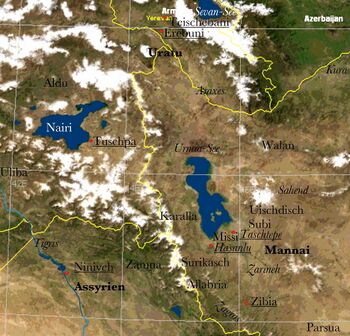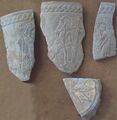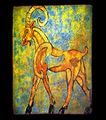منائيا
منائيا Kingdom of Mannaea منائيا | |
|---|---|
 The historical territory of the state of Mannaea | |
| العاصمة | Izirtu |
| الدين | polytheism |
| الحقبة التاريخية | Antiquity |
| Today part of | إيران |
جزء من سلسلة عن |
|---|
| تاريخ إيران |
 |
|
خط زمني |
منائيا مانيون (/məˈniːə/، وأحياناً تُكتب Mannea؛ بالأكدية: Mannai، العبرية التوراتية: Minni، (מנּי)) أحد الشعوب القديمة التي إستوطنت الأراضي التي تعرف حاليا بآذربيجان الإيرانية في الفترة ما بين القرن العاشر قبل الميلاد و القرن السابع قبل الميلاد وقد ذكر إسمهم في العهد القديم من الكتاب المقدس [1], كان المانييون مجاورين للآشوريين و دولة أرارات، وكذلك كدويلات عازلة صغيرة بين الاثنتين، مثل موصاصير و زيكرتي.
أصل الاسم
The name of Mannaea and its earliest recorded ruler Udaki were first mentioned in an inscription from the 30th year of the rule of Shalmaneser III (828 BC).[1] The Assyrians usually called Manna the "land of the Mannites",[2] Manash,[3] while the Urartians called it the land of Manna.[4]
في وصف زحف شلمنصر الثالث في العام 16 من عهده (843 ق.م.)، أفيد أن الملك بلغ أرض مونـّا Munna, occupying the interior of Zamua. However, the chronicle does not mention any march or taxation on the state of Mannaea. It is possible that the Assyrians either failed to conquer Mannaea, or advanced only to the border of Mannaea, and then changed course and marched on the neighboring country of Allarabia.
In the Bible (Jeremiah 51:27), Mannaea is called "Minni", and is mentioned with Ararat and Ashkenaz as some of the future destroyers of neo-Babylon. The Jewish Encyclopedia (1906), identified Minni with Armenia:
According to the Peshiṭta and Targum Onkelos, the "Minni" of the Bible (Jer. li. 27) is Armenia—or rather a part of that country, as Ararat is also mentioned (Isa. xxxvii. 38; II Kings xix. 37) as a part of Armenia.[5][6]
It can also relate to one of the regions of ancient Armenia, such as Manavasean (Minyas).[7][8] Together with Ararat and Ashkenaz, this is probably the same Minni from the Assyrian inscriptions,[9] corresponding to Mannea. The name "Armenia" has been theorized by some scholars as possibly deriving from "ḪAR Minni," meaning, the “mountains of Minni.”
According to examinations of the place and personal names found in Assyrian and Urartian texts, the Mannaeans, or at least their rulers, spoke a non-Semitic and non-Indo-European language related to Urartian, with no modern language connections.[10] However, after assessing the genetics of individuals found at Hasanlu Tepe, recent scholarship has suggested the possibility of the presence of Indo-Europeans, who perhaps spoke a language related to Armenian.[11]
الموقع
Their kingdom was situated east and south of the Lake Urmia. [12] Excavations that began in 1956 succeeded in uncovering Ziwiyeh and its branches the fortified city of Hasanlu, once thought to be a potential Mannaean site. More recently, another branch of Ziwiyeh, the site of Qalaichi has been linked to the Mannaeans based on a stela with this toponym found at the site.
After suffering several defeats at the hands of both Scythians and Assyrians, the remnants of the Mannaean populace were absorbed by the Matieni and the area became known as Matiene.[13][14] It was then annexed by the Medes in about 609 BC.
العرق
| تاريخ الأكراد |
|---|
| مانيون |
| كاردوخيون |
| ميديون |
| هزوانيون |
| شداديون |
| حسنويون |
| عنازيون |
| مروانيون |
| أيوبيون |
| بدليسيون |
| أردلانيون |
| بهدينانيون |
| سورانيون |
| بابانيون |
النقطة الرئيسية في هذه الأقوام إنهم لم يكونوا من الشعوب الهندو - أوربية ولم يكونوا خاضعين لسيطرة الإمبراطوريات المجاورة [2] وتأتي أهمية هذه النقطة في تركيز المؤرخ الكردي محمد أمين زكي (1880 - 1948) في كتابه "خلاصة تاريخ الكرد وكردستان" على إن الشعب الكردي يتألف من طبقتين من الشعوب، الطبقة الأولى التي كانت تقطن كردستان منذ فجر التاريخ "ويسميها محمد أمين زكي" شعوب جبال زاكروس" وهذه الشعوب لم تكن هندو - أوروبية ولكنها إمتزجت مع الشعوب الهندو- أوربية مثل الميديين التي هاجرت إلى كردستان في القرن العاشر قبل الميلاد، واستوطنت كردستان مع شعوبها الأصلية. وكان هذا الشعب غير متنقل بل ثابتا في بقعته الجغرافية وكانوا يعتمدون على الزراعة وتربية المواشي.
يرى المؤرخ الكردي محمد أمين زكي (1880 - 1948) في كتابه "خلاصة تاريخ الكرد وكردستان" بإن هناك إحتمالا كبيرا بأن هذه المجموعة تشكلت من عدة قبائل مثل "لولو، كوتي، كورتي، جوتي، جودي، كاساي، سوباري، خالدي، ميتاني، هوري، نايري" . في القرن الثامن قبل الميلاد إتخذوا من مدينة زرتا عاصمة لهم [3] ووصلوا إلى اوج قوتهم بين عامي 725 و 720 قبل الميلاد ولكن الصراع بدأ بالظهور بينهم وبين الآشوريين وإستطاع الملك الآشوري سرجون الثالث بالقضاء على حكمهم في عام 716 قبل الميلاد .
إصول هذه الأقوام غير معروفة على وجه الدقة ولكن هناك إجماعا على إنهم اقوام غير هندو - أوروبية وهذه الصفة حدى بالكثير من المؤرخيين الأكراد إلى طرح فرضية ان هذه الأقوام قد يكونون احد الأصول القديمة للشعب الكردي ولكن لايتوفر اي إثبات أكاديمي على هذه الفرضية لحد هذا اليوم [4].
التاريخ
The Mannaean kingdom began to flourish around 850 BC. The Mannaeans were mainly a settled people, practicing irrigation and breeding cattle and horses. The capital was a fortified city called Izirtu (Zirta).
By the 820s BC, Manneaea had expanded to become a large state. By this time they had a prominent aristocracy as a ruling class, which somewhat limited the power of the king.
Beginning around 800 BC, the region became contested ground between Urartu, which built several forts on the territory of Mannaea, and Assyria. In the mid-8th century BC, during the open conflict between the Assyrians and the Urartians, Mannaea seized the opportunity to enlarge its holdings. The Mannaean kingdom reached the heightof its power during the reign of Iranzu (c. 725–720 BC).
In 716 BC, king Sargon II of Assyria moved against Mannaea, where the ruler Mannaea, Aza, the son of Iranzu, had been deposed by Ullusunu with the help of the Urartians. Sargon took Izirtu, and stationed troops in Parsua (Parsua was distinct from Parsumash located further southeast in what is today known as Fars province in Iran.). The Assyrians thereafter used the area to breed, train and trade horses.
According to one Assyrian inscription, the Cimmerians (Gimirru) originally went forth from their homeland of Gamir or Uishdish in "the midst of Mannai" around this time. The Cimmerians first appear in the annals in the year 714 BC, when they apparently helped the Assyrians to defeat Urartu. Urartu chose to submit to the Assyrians, and together the two defeated the Cimmerians and thus kept them out of the Fertile Crescent. The Cimmerians again rebelled against Sargon by 705 BC, and he was killed while driving them out. By 679 BC the Cimmierians migrated to the east and west of Mannaea.
The Mannaeans are recorded as rebelling against Esarhaddon of Assyria in 676 BC, when they attempted to interrupt the horse trade between Assyria and its colony of Parsua.
The Mannaean king Ahsheri, who ruled until the 650s BC, continued to enlarge the territory of Mannaea, although paying tribute to Assyria. However, Mannaea suffered a crushing defeat at the hands of the Assyrians around 660 BC, and subsequently an internal revolt broke out, continuing until Ahsheri's death. Also in the 7th century BC, Mannaea was defeated by the advancing Scythians, who had already raided Urartu and been repelled by the Assyrians. This defeat contributed to the further break-up of the Mannaean kingdom.
Ahsheri's successor, Ualli, as an ally of Assyria, took the side of the Assyrians against the Medes (Madai), who were at this point still based to the east along the southwest shore of the Caspian Sea and revolting against Assyrian domination. The Medes and Persians were subjugated by Assyria. However, the Neo-Assyrian Empire, which had dominated the region for three hundred years, began to unravel, consumed by civil war after the death of Ashurbanipal in 627 BC. The upheavals in Assyria allowed the Medes to free themselves from Assyrian vassalage and make themselves the major power in Iran. At the battle of Qablin in 616 BC, the Assyrian and Mannaean forces were defeated by Nabopolassar's troops. This defeat laid open the frontiers of Mannaea, which fell under the control of Media between 615 BC and 611 BC.[15]
ملوك منائيون
معرض صور
انظر أيضاً
الهامش
- ^ Hassanzadeh and Mollasalehi. "New Evidence for Mannean Art: An Assessment of Three Glazed Tiles from Qalaichi (Izirtu)." Elam and Persia. Eisenbrauns. 2011. p. 408.
- ^ William Bayne Fisher,Ilya Gershevitch,Ehsan Yar-Shater,Peter Avery – The Cambridge history of Iran, Том 2, page 74
- ^ ARAB, I, 637, 739
- ^ UKN №28
- ^ Jewish Encyclopedia, Leopold Zunz, Moritz Steinschneider, Solomon Schechter, Wilhelm Bacher, J.L. Rapoport, David Zvi Hoffman, Heinrich Graetz, etc; Funk and Wagnalls, 1906;http://www.jewishencyclopedia.com/articles/1787-Armenia
- ^ The Biblical Geography off Central Asia: With a General Introduction to the Study of Sacred Geography, including the Antediluvian Period, Volume 2, Ernst Friedrich Carl Rosenmüller, 2011, Nabu Press, ISBN 978-1245629010
- ^ Missionary Researches in Armenia: Including a Journey Through Asia Minor, and Into Georgia and Persia, with a Visit to the Nestorian and Chaldean Christians of Oormiah and Sarmas, Smith, Eli; Conder, Josiah and Dwight, Harrison Gray Otis, ISBN 9781147547535
- ^ Cyclopaedia of Biblical, theological, and ecclesiastical literature Volume 1, John McClintock, James Strong; (orig. 1923, 2010), Nabu Press, ISBN 978-1177267625
- ^ International Standard Bible Encyclopedia s.v. Minni
- ^ Iranian Identity in Ancient Times Richard N. Frye Iranian Studies, Vol. 26, No. 1/2 (Winter - Spring, 1993), pp. 143-146
- ^ Lazaridis, Iosif; et al. (26 August 2022). "A genetic probe into the ancient and medieval history of Southern Europe and West Asia". Science. 377 (6609): 940–951. Bibcode:2022Sci...377..940L. doi:10.1126/science.abq0755. PMC 10019558. PMID 36007020.
- ^ Encyclopædia Britannica. Mahābād. Retrieved Oct 3, 2011.
There are a number of unexcavated tells, or mounds, on the plain of Mahābād in this part of the Azerbaijan region. The region was the centre of the Mannaeans, who flourished in the early 1st millennium BC.
- ^ The Cambridge history of Iran, Volume 2 by William Bayne Fisher, Ilya Gershevitch, Ehsan Yar-Shater, Peter Avery, pages 256-257
- ^ Archaeology at the north-east Anatolian frontier, I.: an historical geography and a field survey of the Bayburt Province by A. G. Sagona, Claudia Sagona, pages 41-48,
- ^ The Cambridge History of Iran, Volume 2 : page 122
- ^ Nikdiara (Mektiara)
وصلات خارجية







